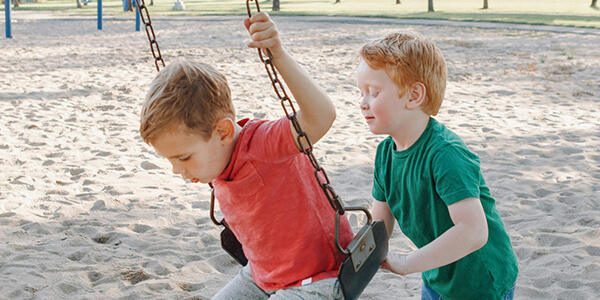Lasting Action

Early Intervention is Life Changing

"In order for man to succeed in life, God provided him with two means; education and physical activity. Not separately, one for the soul and one for the body but for the two together. With these two means, man can attain perfection."
Plato
Movement and Mental Health
Physical mastery leads to self-mastery. If the physical body is disorganized, the mind is disorganized. If the mind is disorganized, it affects our sense of self, our relationships with others and our ability to make good choices. This can cause a cascade of undesirable outcomes, including poor self-image, where the person feels physically “uncoordinated,” “not good at sports,” or “uncomfortable in their own skin.”
These seemingly trivial issues can have a profound impact on life success. Sadly, these “symptoms” are not often identified until a child is school-aged and struggling academically and socially. Ideally, we are trained to watch for these symptoms - and intervene - within the first years of a child’s life. In infancy, this can be seen as fussy behavior. In early childhood, it can be a factor in bed-wetting and emotional outbursts. And, in adolescence, it might contribute to promiscuity, drug use, or self-harm. The list goes on to include anxiety, depression, and deaths of despair. Conversely, children who enjoy consistent, targeted and natural movement in infancy and early childhood, tend to be physically “organized,” and more confident and competent physically, socially and academically.
Self-confidence, self-esteem and self-agency are all traits associated with good mental health. According to the CDC, “Mental health includes our emotional, psychological, and social well-being. It affects how we think, feel, and act. It also helps determine how we handle stress, relate to others, and make healthy choices. Mental health is important at every stage of life, from childhood and adolescence through adulthood.”
"What if, for instance, we could reduce suicide rates of the future by helping kids develop and sustain healthy coping mechanisms early?"

The Role of Self-Agency
We have a number of epidemics we are frantically trying to resolve. Learning and behavior challenges in America’s classrooms, obesity, chronic illness, drug addiction and suicide. What if there was a common thread among these? Underlying these conditions is a critical factor; to be healthy and well-adjusted, children need to be confident and have a sense of self-agency. In other words, they need to feel like they have control over their bodies, their actions, their relationships, and ultimately, the direction of their life. In other words, to have good mental health, people need to have a strong sense of self-agency. (de Ridder)
A recent research article states that higher self-agency is associated with increased resilience to stress, lower levels of cortisol, increased motivation and curiosity. (Mehta) The article goes on to say that those with higher self-agency have “more flexible and goal-directed behaviors and overall well-being.” In addition, self-agency is associated with higher levels of the reward hormone, dopamine. This is the same neurotransmitter pumped through our bodies when we play video games, gamble, anticipate eating a sugary snack or engage in other activities that make us feel good. When we lack a sense of self-agency, there is a tendency to engage in behaviors that provide that dopamine rush but which often lead to very negative outcomes for individuals and for society as a whole.

Securely attached children come to know what makes them feel good or bad.
How is Self-Agency Developed?
Three foundational elements for developing self-agency include: secure attachment in infancy, quality early movement experiences and nutritional building blocks that support a healthy nervous system.
Secure Attachment. In the book The Body Keeps the Score, Bessel Van der Kolk states that, “a secure attachment in infancy, and the cultivation of competency, leads to an internal locus of control. This is key to healthy coping and self-regulation.” (Van der Kolk) A sense of secure attachment is formed when parents or caregivers consistently respond to a baby’s needs; when they are hungry and are fed, for example. Receiving this type of attention during the earliest stages of life helps children develop a sense of safety, creating the neurological foundation for social-emotional regulation later in life. Van der Kolk goes on to explain that securely attached children come to know what makes them feel good or bad and what makes others feel good or bad, acquiring a “sense of agency,” a sense of knowing that “their actions can change how they feel and how others respond.” These are foundational traits for the development of empathy, which is a component of Emotional Intelligence (EQ).

Early Movement. Coupled with secure attachment, a child needs physical movement that helps organize the brain circuitry affecting organization of a child's sensory systems. When information comes into the child’s brain through their sense of spatial awareness, sight, hearing, touch, smell and taste, that information needs to be organized and processed in the brain in a way that helps the child make sense of their world. When the world makes sense, the child has a greater sense of control, or agency. In this way, early movement experiences contribute to the development of self-agency.
According to Van der Kolk, when the body is disorganized and these critical elements are not in place, whether through exposure to trauma, developmental delays, or disorders like ADHD and autism, the nervous system is off-line. This can result in increased levels of the stress hormone, cortisol, and a perpetual state of hyper-vigilance or hyper-arousal, which we often see in dysregulated children, as they react to events with a fight, flight or freeze response, lacking a sense of control over themselves and their environment. When a person consistently experiences the world in this way, it creates a sense of chaos and unpredictability. A nervous system in a constant state of “survival mode,” leads the person to seek relief in whatever ways are most immediate. Van der Kolk describes “the need to dull the intolerable inner world” through self-numbing and sensation-seeking behaviors.
Drug and alcohol use, cutting, promiscuity, and other risky behaviors often begin in childhood and early adolescence. Society views these conditions as problems to be solved; however, for the individual living in a chaotic inner world, these behaviors are, in their mind and body, a solution to their problem.

Nutrition. Perhaps one of the most important, and overlooked, factors in early brain development is proper nutrition, beginning during pregnancy. A diet rich in Omega 3 fatty acids is especially important, as these are the building blocks for the myelin sheath that insulates nerve axons. (Kanellopoulos) Omega 3’s are found in olive oil, salmon, avocados and other foods considered to have “healthy fats.”
When a child reaches for a toy or crawls across the floor toward an object, their attention, coupled with the movement of their body, is sending signals across nerve networks that build and strengthen their brain’s capacity for learning. This can only occur if there is a protective layer of myelin along the axons that connect those nerve networks. An unmyelinated nerve axon is like a gravel road, where information travels much slower and may even get lost altogether. By comparison, well-myelinated axons are like superhighways. And, the more often a signal travels across those roads, the more myelin is laid down, reinforcing the connections.
This is where the concept, “nerves that fire together, wire together” comes into play. A key takeaway is that the body does not make the types of fatty acids needed to build the myelin sheath. This nutrient must come from our diet during pregnancy, breastfeeding and infancy. A developing baby needs this critical nutrient before it is even born. Well-insulated myelin sheaths are crucial for the formation of the vestibular system, the first sensory system, which develops while a child is still in the mother's womb. The vestibular system is foundational to the organization of nearly all other sensory systems, affecting how information is processed and stored in the brain. This, in turn, affects a child’s ability to learn, process emotional states and attain higher order thinking as they grow.
For the benefits of secure attachment and movement experiences to be realized, the building blocks of the neural networks must be in place. Without a diet rich in healthy fats, the time and energy spent on quality parental attention and movement won’t have its intended impact. It’s also worth noting that, for many years, all fat was considered bad, leading us to eliminate healthy fats from our diets for decades without realizing the consequences. I am often surprised how many people are still advocating for a low-fat diet for children. It appears we have more work to do in teaching leaders about the role of healthy fats in brain development and nervous system function.
What Happens After Age Three?

What happens if we miss the early window of intervention? Thanks to neural plasticity, (the brain’s ability to change,) the same three elements of attachment, movement and nutrition, can help older children and adults attain a “locus of control” where previously they felt out-of-control. Many adults struggle with feelings associated with chronic stress and anxiety. The treatment for a dysregulated, disrupted nervous system is the same across the life span. In order for the systems of the body to be organized, we need to feel a sense of connection and safety with others. We must move our bodies in ways that strengthen and organize the nervous system, including breathing, and we need to ensure we are eating foods with the nutrients our bodies need to build the infrastructure of support for a healthy nervous system, namely healthy fats, fruits and vegetables.
For some, this may be an oversimplification. It is also important for people to seek guidance from a medical professional to identify serious conditions requiring medical treatment. For most people, however, consistent, positive interpersonal connections, movement and nutrition will be enough to establish a sense of self-agency that is a springboard to good mental health and overall well-being.
References
de Ridder, D., Adriaanse, M., & Fujita, K. (Eds.). (2017). Routledge International Handbook of Self-Control in Health and Well-Being (1st ed.). Routledge. https://doi.org/10.4324/9781315648576
Mehta MM, Na S, Gu X, Murrough JW, Morris LS. Reward-related self-agency is disturbed in depression and anxiety. PLoS One. 2023 Mar 15;18(3):e0282727. doi: 10.1371/journal.pone.0282727. PMID: 36920973; PMCID: PMC10016695.
Vasilopoulos F, Ellefson MR. Investigation of the associations between physical activity, self-regulation and educational outcomes in childhood. PLoS One. 2021 May 19;16(5):e0250984. doi: 10.1371/journal.pone.0250984. PMID: 34010304; PMCID: PMC8133416. Access from https://www.ncbi.nlm.nih.gov/pmc/articles/PMC8133416/
Van der Kolk, B. A. (2015). The body keeps the score: brain, mind, and body in the healing of trauma. New York, New York, Penguin Books.
Kanellopoulos AK, Costello S, Mainardi F, Koshibu K, Deoni S, Schneider N. Dynamic Interplay between Social Brain Development and Nutrient Intake in Young Children. Nutrients. 2023 Aug 28;15(17):3754. doi: 10.3390/nu15173754. PMID: 37686785; PMCID: PMC10490067. Accessed at https://www.ncbi.nlm.nih.gov/pmc/articles/PMC10490067/
Join the Movement
updates, activities, and info.

